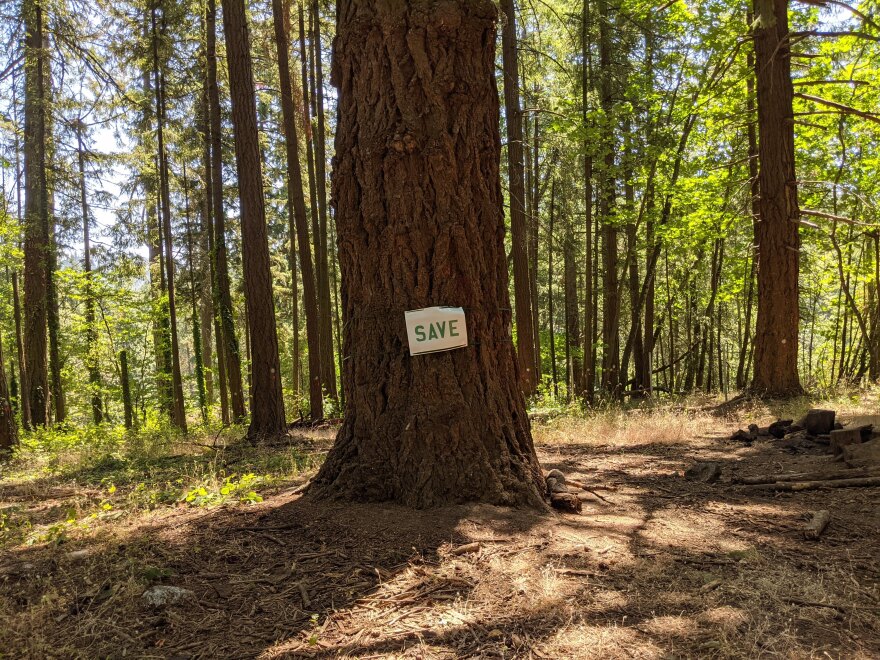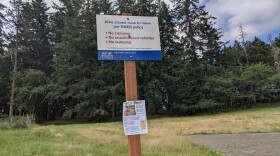A plan to build new water storage in south Eugene has some residents upset. They object to tree removal and construction at a site that has been an urban forest for more than 60 years. But, Eugene Water & Electric says the property was always meant for water storage.
Water storage is necessary for a resilient system and things like fire suppression and disaster preparedness. EWEBpurchased this 10½-acre property at east 40th and Patterson in South Eugene in the 1950s for a future water storage site. And now the utility says it’s time to decommission and replace its aging reservoirs at College Hill and Hawkins Lane.
This location is at a sweet spot: 607 feet in elevation.
“That allows us to serve the community by gravity,” EWEB Engineer Laura Farthing said. “So, that allows water to flow in and out and it is the most reliable, economical, and environmental way to bring water to people.”
Laura Farthing is in charge of the project to build two 7.5 million gallon water tanks here. Once these are online, EWEB’s 80-year-old College Hill reservoir, which holds 15 million gallons, can be decommissioned.
“This is really a project about water,” Farthing said. “It is cool because it’s a legacy project. It’s our generation’s College Hill. We get to create something that generations after generations will get to use. And this site will go back to being open and public and it will provide high quality drinking water for, these tanks have a 100 year life-span.”
But even though the project is about water, it’s also about trees.
[asset-pullquotes[{"quote": "We've allowed the trees to grow and now, given other circumstances, it's time to put it to its intended use. ", "style": "push"}]]
Some community members don’t want this oasis of forest in a residential neighborhood disturbed. And they don’t want to lose a couple hundred trees to accommodate the project. Sam Schmieding is with Save EWEB Forest.
“It’s a cooling island,” Schmieding said. “And for them to be ready to clearcut a big portion of it, during a heat wave, and start cutting during this drought, with this wind that we’ve had the whole last several months just seems to be a little bit too much.”
Schmieding and others don’t object to water storage. But they think EWEB should only build one tank so more trees can be saved.
“I really understand the need for the water infrastructure,” Schmieding said. “As an environmental historian, I am not naïve about realpolitik and infrastructure and the fact that water is necessary for life. But to do it like this seems to be reckless and over the top.”
But the utility says it had always planned to put two tanks here. At one point they were going to build them one at a time. After last year’s Holiday Farm Fire, they decided it made more sense to build both at once. EWEB’s Joe Harwood said this plan is more efficient and ultimately will have less impact on the neighborhood.
“And we found we would save well over a million dollars if we did them both at once by not having to have a contractor mobilize twice,” Harwood said. “And we also discovered that we could eliminate 2100 truck trips and that reduces carbon emissions and wear and tear on the streets and I’m sure the adjacent neighborhood would appreciate 2,100 less trucks.”
The project is expected to take three years. And 15-thousand truck trips. The cost is $25 million. The property will be excavated to accomodate the 7.5 million gallon tanks. EWEB told KLCC the impact of the noise and vibrations from drilling will be minimal. But they will warn residents ahead of time.
Project critics also decry the process for public involvement. At a recent EWEB public hearing many people said they’d only just heard of the plans. The utility started public meetings in March of 2020, and then the pandemic put the brakes on things. EWEB Commissioner John Barofsky said there’s a limit to how much the public can be involved in technical decisions.
“The public process of it I think is letting the people know what’s going to happen and doing our best to mitigate the impacts that the construction will have on the neighbors is the best thing that we can do,” Barofsky said.
He told KLCC he’s heard from protesters and supporters of the project.
“They see that a resilient and effective water system is something that is very important to the 200,000 plus customers that this will affect,” Barofsky said.

EWEB’s Laura Farthing acknowledged cutting down trees is painful. They plan to remove about 25 percent of the trees here, including a couple of Douglas Firs that are estimated at around 150 years old. But they’re preserving 8 acres of oak savanna, which is rare in the Willamette Valley now because of development. And, this small EWEB forest wouldn’t exist if the utility hadn’t originally purchased it with the water storage facility in mind.
“We’ve allowed the trees to grow and now, given other circumstances, it’s time for us to put it to its intended use,” Farthing said. “And it’s hard. There’s a grieving process. It’s a lovely, quiet peaceful site. And it will be lovely and quiet and peaceful once the construction is over. Just like our other reservoir sites that are in the middle of residential neighborhoods.”
The trees are scheduled to be removed as soon as next week.
EWEB is a KLCC underwriter.
Copyright 2021 KLCC.









